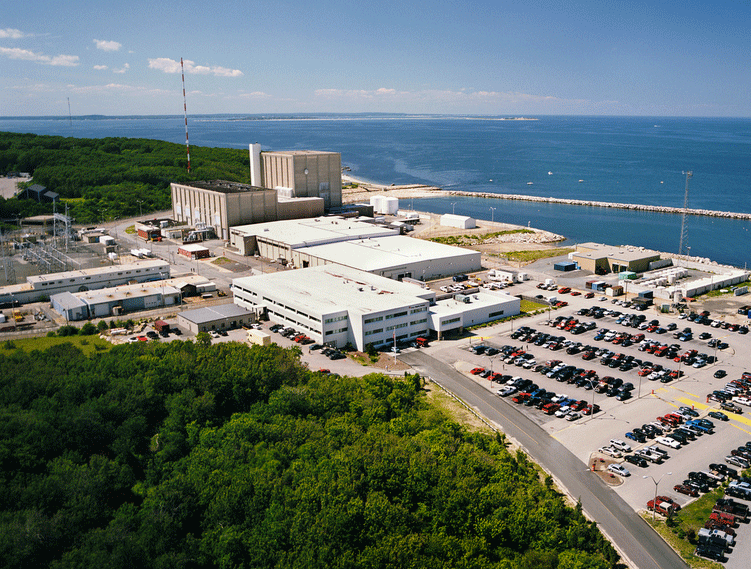Citizens Sue Nuclear Facility
Air Date: Week of October 12, 2012

Pilgrim Nuclear Power Station (Entergy Nuclear)
A group of Massachusetts citizens is planning to use the Clean Water Act to sue the Entergy Corporation for environmental violations at their Pilgrim Nuclear Power Station. The group says the company should pay nearly a billion dollars in penalties. The citizens' lawyer, Meg Sheehan, laid out the details of the case to host Steve Curwood, and Vermont Law School Professor Patrick Parenteau explained the wider context.
Transcript
CURWOOD: From the Jennifer and Ted Stanley Studios in Boston, this is Living on Earth. I'm Steve Curwood. A group of citizens has filed an intent to sue the Entergy Corporation, alleging that the Pilgrim Atomic Power Station in Plymouth Massachusetts has violated the Clean Water Act.
They say the plant has polluted Cape Cod Bay, massively killed local fish populations, and the operators kept inadequate environmental records. Entergy could be liable for over 800 million dollars in penalties. Citizens have the right to sue when the government fails to enforce the Clean Water Act so if the EPA does not step in within 60 days, this plaintiff group can proceed. Their lead attorney is Meg Sheehan of EcoLaw.
SHEEHAN: Well, at this point we're alleging they have violated the federal Clean Water Act on over 33,000 separate occasions by discharging pollutants at levels that exceed those permitted in their Clean Water Act permit, and also that they’re failing to adequately monitor and report some of the discharges that they’re dumping out into the bay.
Since about 2000 when Entergy took over Pilgrim from Boston Edison, Entergy has failed to obtain EPA’s approval for their marine monitoring plan. To us that’s a really egregious violation because when Pilgrim was built in the ’70s, there was great concern in the scientific community among the fishermen and the fisheries experts that there would be this terrible impact and these very strict provisions were put in for regulatory oversight. But when Entergy came in, they pretty much told the regulators that they weren’t willing to participate with this oversight advisory committee, so that’s the crux of our allegations.
CURWOOD: How is it that Entergy is killing thousands of fish, you say?
SHEEHAN: First of all, they’ve taken 510 million gallons of cooling water a day from Cape Cod Bay. Any kind of marine life, whether it’s a fish or plankton – anything that can’t avoid this velocity of the pumps gets sucked into the plant – and some of the bigger fish get slammed against these screens and trash racks that they have. The fish are killed either than being impinged and killed on the screens, or they’re sucked in and basically fried. Back in the 1990s, the state Marine Fisheries Department stated that Pilgrim’s operation had killed off up to 40 percent of the winter flounder population.

A sign shows the evacuation route from the Pilgrim Nuclear Power Station. (Photo: Timothy Valentine)
CURWOOD: Why did you decide to use the citizen law provision in the Clean Water Act to launch this case?
SHEEHAN: Well, really we had no other option. We’d been talking with federal regulators and state regulators since early this year, urging them to look closely at this, to look closely at these monitoring reports and look at the violations and to review Entergy’s permit which expired 16 years ago to make sure that they were doing the proper monitoring, and no action was taken. This plant is going to be operating for another 20 years from what we understand, so we just felt this was our only option.
CURWOOD: What’s your ultimate goal here - do you want them to clean up their act or do you just want them to shut this nuclear power plant down?
SHEEHAN: I think it’s unrealistic to think that we’d be able to shut it down. We’ve accepted the reality that it has been relicensed by the NRC, and our view is that if it’s going to continue to operate with this kind of environmental destruction, is unacceptable, these kinds of violations are unacceptable, and the EPA really does have to take a solid look at this and update the permit.
CURWOOD: Meg Sheehan is an attorney with Eco Law, thank you so much.
SHEEHAN: Thank you very much.
CURWOOD: Living on Earth contacted the Entergy Corporation seeking comment on the potential lawsuit. Pilgrim Station Spokesperson Carol Wightman sent this statement: “Entergy takes its environmental responsibilities and any allegation of noncompliance seriously. We will respond to the notice of intent after we have had a chance to thoroughly review the specific allegations. We note that EcoLaw unsuccessfully raised a number of these allegations in the NRC license renewal proceeding for Pilgrim Station.”
Well, to assess the wider implications of this case we turn now to Patrick Parenteau, Professor of Law at Vermont Law School. Welcome to Living on Earth!
PARENTEAU: Thank you Steve, good to be here!
CURWOOD: Now, how have citizens used the Clean Water Act to sue nuclear power companies in the past?
PARENTEAU: It’s very rare. Nuclear power plants, of course, are regulated primarily by the Nuclear Regulatory Commission, federal law actually preempts state law, and even preempts the Clean Water Act, when it comes to radiological health and safety issues, so you don’t see very many citizen suits against nuclear power plants under the Clean Water Act. So this case does represent sort of taking it to a whole ’nother level in terms of using the Clean Water Act against a nuclear power plant.
CURWOOD: This group is looking for almost a billion dollars in damages – how realistic is that?
PARENTEAU: Well, I don’t think that’s realistic. I understand the citizens have alleged that because the statutory maximum penalty is over 32 thousand dollars per day per violation, and they’re alleging tens of thousands of violations going back many years. It’s unheard of that a court would actually award such a massive amount of penalties.
It is possible, in these cases, to have penalties over a million dollars. In fact, a group called Earth Island sued the San Onofre nuclear power plant in California back in the ’90s and achieved a 17 million dollar settlement in that case. So you can think about a large, potential damage award, but nothing in the billion-dollar range.
CURWOOD: Who would get the money?
PARENTEAU: Well, it either goes to the United States Treasury, if the court assesses the penalty, or, if there’s a settlement agreement, the plaintiffs, the citizen group, and the plant owner, Entergy, could create what are called environmental credit projects. In fact, there was one done for Boston Harbor many years ago. And these are projects that improve water quality, sometimes they restore wetlands, sometimes they create public education programs, there’s a variety of things that could be agreed to in a settlement agreement – in lieu of a penalty going to the Treasury, the money would go to an environmentally beneficial project.
CURWOOD: Now, I understand that the plaintiffs are basing some of their allegations on the company’s own reports and filings themselves.
PARENTEAU: That’s correct. They’re called discharge monitoring reports, they’re required by law, they’re required to be made public. The courts have said these documents are in the nature of an admission of liability, so that gives the plaintiffs in these cases the upper hand. Now, the real question is going to come down to: do the discharge monitoring reports actually reveal the violations that the plaintiffs have alleged, and that will turn on how you interpret the terms of the permit.
These discharge permits are huge documents with many provisions and conditions and terms. So I anticipate that there will be a lot of argument about what the permit actually requires, and whether the discharge monitoring reports are actually showing a violation or not.
CURWOOD: Now, I know that you don’t have a crystal ball there at the Vermont Law School, but what kind of chance do you think they have for this case?
PARENTEAU: I think they have a chance of either getting a judgment in their favor on some of these allegations, or maybe even more realistically a settlement. The California case, again, comes to mind. In that case, a senior judge in that case was appointed as the quote “mediation judge.”
And these mediation judges have tremendous power to kind of force the parties into a settlement agreement basically saying neither one of you can be sure who is going to win, and you both have a lot to lose, so I am going to meet with you and require that you’d make a serious effort to try to settle your differences. I could see something like that coming out of this case.
CURWOOD: What do you think might be the financial impact of this case on Entergy at the end of the day?
PARENTEAU: Yeah, that’s really hard to judge. It’s not going to be anywhere near the maximum that the citizens are seeking, but I think it could be significant enough that Entergy may reevaluate the economics of the continued operations of a plant like this. These plants, these older plants, are reaching the end of their useful lives, of their economic lives, so a major judgment against them for a water quality violation could tip in the favor of shutting it down earlier rather than later.
CURWOOD: To what extent to you anticipate this tactic being replicated with other nuclear power plants now?
PARENTEAU: Well, there’s a lot of these nuclear plants, the Indian Point plant in New York, the Oyster Creek plant in New Jersey and many others - that are in the relicensing process. They’re older plants, mostly over 40 years old, they probably were not certainly state-of-the-art when they were built, they’ve demonstrated that they had significant impacts on water quality and other environmental conditions, so I guess I would expect more citizen groups located in the vicinity of these plants to be looking for every possibility of either shutting them down, which is happening in some places, or requiring them to install much better technology to protect the environment. So, I think this case may signal - I don’t know if you call it a wave - but this isn’t the last of these kinds of cases that we’re going to see.
CURWOOD: Pat Parenteau is Professor of Law at the Vermont Law School, thanks so much for joining us!
PARENTEAU: You're welcome, Steve!
Living on Earth wants to hear from you!
Living on Earth
62 Calef Highway, Suite 212
Lee, NH 03861
Telephone: 617-287-4121
E-mail: comments@loe.org
Newsletter [Click here]
Donate to Living on Earth!
Living on Earth is an independent media program and relies entirely on contributions from listeners and institutions supporting public service. Please donate now to preserve an independent environmental voice.
NewsletterLiving on Earth offers a weekly delivery of the show's rundown to your mailbox. Sign up for our newsletter today!
 Sailors For The Sea: Be the change you want to sea.
Sailors For The Sea: Be the change you want to sea.
 The Grantham Foundation for the Protection of the Environment: Committed to protecting and improving the health of the global environment.
The Grantham Foundation for the Protection of the Environment: Committed to protecting and improving the health of the global environment.
 Contribute to Living on Earth and receive, as our gift to you, an archival print of one of Mark Seth Lender's extraordinary wildlife photographs. Follow the link to see Mark's current collection of photographs.
Contribute to Living on Earth and receive, as our gift to you, an archival print of one of Mark Seth Lender's extraordinary wildlife photographs. Follow the link to see Mark's current collection of photographs.
 Buy a signed copy of Mark Seth Lender's book Smeagull the Seagull & support Living on Earth
Buy a signed copy of Mark Seth Lender's book Smeagull the Seagull & support Living on Earth

